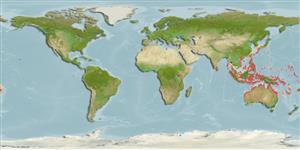Common names from other countries
Environment: milieu / climate zone / depth range / distribution range
Ecologia
marinhas; Água doce; estuarina demersal; anfídromo (Ref. 59012); intervalo de profundidade 0 - 5 m (Ref. 86942). Tropical; 22°C - 28°C (Ref. 12468)
Indo-West Pacific: Philippines and Indonesia (also Sunda Is.) through to Micronesia, southern Japan, Papua New Guinea, the Solomon Islands, Vanuatu, Fiji and New Caledonia.
Tamanho / Peso / Idade
Maturity: Lm ? range ? - ? cm
Max length : 14.0 cm SL macho/indeterminado; (Ref. 48637)
Espinhos dorsais (total) : 7; Raios dorsais (total) : 8; Espinhos anais: 1; Raios anais : 8 - 9; Vértebras: 25. This species is distinguished by the followingcharacters: no scales between eyes and orbital ridges, IOS 0/1-3/0; jaws reaching back to below front part of eye; absence of auxiliary scales on body; body depth at anal fin origin 13-17% SL (Ref. 130228).
This species is reported to occur in many coastal streams in brackish to freshwaters and estuaries over substrates of mud, sandy mud or leaf litter and is often observed clinging upside down under dead wood, eyes facing downwards. An ambush hunter, feeding mainly on small fish and crustaceans (shrimps (Atyidae), prawns (Palaemonidae)) (Ref. 130228). .Usually found in brackish mangrove areas and in creeks and rivers, sometimes well upstream (Ref. 2847), 48637).
Ciclo de vida ou comportamento de acasalamento
Maturities | Reprodução | Spawnings | Egg(s) | Fecundities | Larvas
Keith, P. and M.I. Mennesson, 2023. Review of Butis (Teleostei: Butidae) from Indo-Pacific islands with description of three new species. Cybium 47(4):431-466. (Ref. 130228)
Status na Lista Vermelha da UICN (Ref. 130435)
CITES (Ref. 128078)
Not Evaluated
Ameaça para os humanos
Harmless
Uso pelos humanos
Pescarias: espécies comerciais; Aquário: Espécies comerciais
Ferramentas
Relatórios especiais
Baixar XML
Fontes da internet
Estimates based on models
Preferred temperature (Ref.
115969): 24.9 - 29.3, mean 28.6 (based on 2274 cells).
Índice de diversidade filogenética (Ref.
82804): PD
50 = 0.5156 [Uniqueness, from 0.5 = low to 2.0 = high].
Bayesian length-weight: a=0.00617 (0.00312 - 0.01219), b=3.01 (2.83 - 3.19), in cm Total Length, based on LWR estimates for this species & (Sub)family-body (Ref.
93245).
Nível Trófico (Ref.
69278): 4.2 ±0.7 se; based on size and trophs of closest relatives
Resiliência (Ref.
120179): Elevada, tempo mínimo de duplicação da população menor que 15 meses (Preliminary K or Fecundity.).
Fishing Vulnerability (Ref.
59153): Low vulnerability (10 of 100).
